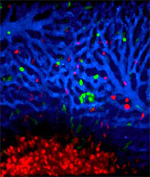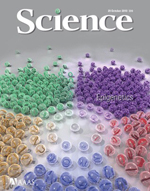 This month in Science Roundup: Sponsored by:
Explore the T cell from any perspective. BD Biosciences offers a full range of flow cytometric tools to simplify studies of cytokines and phosphorylated proteins and give you more information and insight. Register today for free webinars and learn about our advanced tools for T-cell research.  LCROSS Insights LCROSS InsightsAbout a year ago, a spent upper stage of an Atlas rocket was deliberately crashed into a crater at the south pole of the Moon, ejecting a plume of debris, dust, and vapor. The goal of this event, the Lunar Crater Observation and Sensing Satellite (LCROSS) experiment, was to search for water and other volatiles in the soil of one of the coldest places on the Moon: the permanently shadowed region within the Cabeus crater. In the 22 Oct 2010 Science, six research papers detailed observations from the experiment. Colaprete et al. presented data from near-infrared and ultraviolet/visible spectrometers, which reveal the presence of water and other volatiles within the ejecta cloud. Using an ultraviolet spectrograph onboard the Lunar Reconnaissance Orbiter (LRO), Gladstone et al. detected hydrogen, carbon monoxide, mercury, calcium, and magnesium in the impact plume. Paige et al. mapped cryogenic zones predictive of volatile entrapment, and Mitrofanov et al. used LRO instruments to confirm that surface temperatures in the south polar region persist even in sunlight. Finally, Schultz et al. and Hayne et al. provided additional details about the impact event itself. Collective Intelligence People who are good at solving one type of brainteaser tend to excel at a variety of mental tasks, which supports the concept of "general intelligence." In the 29 Oct 2010 Science (published online 29 Sep), Woolley et al. provide evidence that groups have an analogous "collective intelligence" that predicts their performance on a range of collaborative tasks. The researchers reached this conclusion after studying 699 people working in small groups. Participants were randomly assigned to groups of two to five people, and asked to perform a variety of tasks, including visual puzzles, brainstorming, and making collective judgments (listen to the related podcast interview with lead author Anita Woolley). Just as in measures of general intelligence, groups that were better at one task tended to perform better on other tasks as well. However, the researchers found that group performance was not correlated with either the average intelligence of group members or the intelligence of a group's smartest member, but rather to three other group characteristics: the average social sensitivity of group members, the equality in distribution of conversational turn-taking, and the proportion of females in the group. Understanding and manipulating these factors may help increase performance in settings such as research and management, where tasks are increasingly accomplished by groups. A News story by G. Miller in the 1 Oct issue highlighted the study.  Neutrophils to the Rescue Neutrophils to the RescueNeutrophils are a common type of white blood cell that responds not only to microbial infections, but also to sterile injury caused, for example, by trauma or organ necrosis. In a study described in the 15 Oct 2010 Science, McDonald et al. used dynamic in vivo imaging to investigate the underlying mechanisms of recruitment of neutrophils into injured tissue (see the related video of neutrophils called to action in the Science Video Portal). Through a multistep cascade of molecular events that begins with ATP released by dying cells, and also involves the formation of a chemokine gradient, and mitochondrial signal peptides, circulating neutrophils are quickly guided through intravascular channels to the site of injury. The researchers propose that this cascade has evolved to allow neutrophils to remain in the vasculature as they navigate, thereby limiting collateral damage to surrounding healthy tissue. In a related podcast interview, senior author Paul Kubes discussed how the findings could lead to the development of new drugs to thwart the ill effects of excessive inflammation. Stopping the Stones An imbalance in the fluid and mineral content of urine can cause debilitating kidney stones to form. Most of the time, the stones are composed of calcium oxalate crystals. Much less common, but more likely to cause chronic kidney disease, are stones that develop from crystals of the amino acid L-cystine. The rarity of these stones has made clinical trials difficult to conduct, and treatment options have remained unchanged for more than two decades. Now, in the 15 Oct 2010 Science, Rimer et al. report a potential new therapy using compounds to retard cystine crystal growth. Using atomic force microscopy, the team showed that two compounds -- L-cystine dimethylester (L-CMDE) and L-cystine methylester (L-CME) -- dramatically reduce crystal growth in vitro by binding crystal growth sites and impeding the attachment of additional cystine molecules. Although the performance of these compounds in urine remains to be tested, a related Perspective by F. L. Coe and J. R. Asplin noted that such selective inhibitors would offer a potentially more benign alternative to current treatments that require a strict diet and/or drugs that increase urine volume or increase cystine's solubility, all of which can be difficult to tolerate.  Spotlight on Epigenetics Spotlight on EpigeneticsSpecial Online Collection The cells in a multicellular organism have nominally identical DNA sequences (and therefore the same genetic instruction sets), yet maintain different terminal phenotypes. This nongenetic cellular memory, which records developmental and environmental cues (and alternative cell states in unicellular organisms), is the basis of epi-(above)–genetics -- the subject of a special section of the 29 Oct 2010 Science. Review articles delved into the molecular signals of epigenetics; small RNAs as key regulators of epigenetic changes during gametogenesis, fertilization, and early zygotic development; and epigenetic reprogramming in plants and animals. And two Perspectives highlighted the puzzles of paramutation, in which homologous DNA sequences communicate to establish heritable expression states, and prions and the inheritance of environmentally acquired traits. Elsewhere in the issue, a News Focus examined efforts to treat cancer patients with drugs that reverse the abnormal epigenetic patterns found in tumors (listen to the related podcast interview), a Report shed light on how prion phenotypes are created, and a Perspective highlighted what stem cells can tell us about epigenetic perturbations. Online, a video featured experts offering their definition of epigenetics; papers in Science Signaling discussed signaling pathways that alter epigenetic patterning, posttranscriptional regulation of signaling molecules by microRNAs, and transcriptional networks; a paper in Science Translational Medicine described the use of epigenetic markers to predict which liver cancer patients will respond to an anticancer drug; and Science Careers looked at careers embracing a translational approach to epigenetics. New Guinea Colonization After their emergence in Africa by about 200,000 years ago, modern humans colonized the rest of the planet, reaching Australia and New Guinea by 40,000 to 50,000 years ago. Understanding how humans lived and adapted to the range of environments in these areas has been difficult because well-preserved settlements are scarce. Now, in a Report in 1 Oct 2010 Science, Summerhayes et al. describe archaeological evidence of what may be the earliest human occupation of the New Guinea Highlands, which lie some 2000 meters above sea level. The researchers uncovered various stone tools as well as plant remains that demonstrate the exploitation of the endemic Pandanus nut and yams in sites dated to 49,000 to 36,000 years ago in New Guinea's Ivane Valley. Some of the stone tools are thought to have been used to remove trees, which would suggest that inhabitants cleared forest patches to promote the growth of useful plants. An accompanying Perspective by C. Gosden discussed how the new evidence sheds light on the colonization of New Guinea and human adaptation in the region over the past 50,000 years. Benefits of Bt Corn To combat crop pests while reducing reliance on insecticide sprays, corn and cotton have been genetically engineered to make insecticidal proteins derived from the bacterium Bacillus thuringiensis (Bt). These Bt toxins kill some devastating insect pests like the European corn borer moth, but are not harmful to most other organisms, including humans. In the 8 Oct 2010 Science, Hutchison et al. estimate that between 1996 and 2009, Bt corn has saved midwestern U.S. corn farmers a collective $6.9 billion. This tremendous economic success is due in part to a decrease in larval density, a predictor of corn borer population size, in correlation with the percentage of Bt corn planted. However, it is the growers of non-Bt corn who have reaped the most financial benefit. These non-Bt corn farmers can avoid paying premium prices for genetically engineered corn seed, yet still benefit from the so-called "halo effect" -- the suppression of pests on non-Bt plants planted near Bt plants. As noted in an accompanying Perspective by B. E. Tabashnik, the analysis highlights economic incentives for growers to maintain patches of non-Bt corn alongside Bt corn as refuges for insects, which help to prevent the development of Bt resistance.  Trees Fight Pollution Trees Fight PollutionVolatile organic compounds (VOCs) are the most abundant class of carbon-based particles in the atmosphere. Plants release these compounds when they decay, but automobile exhaust, coal burning, and other human activities are a major source. Some VOCs combine with oxygen to form oVOCs, which insulate the atmosphere and lead to global warming, but these particles have been poorly represented in climate models. Now, in a Report published online in ScienceExpress on 21 Oct, Karl et al. have combined field observations, laboratory experiments, and transport modeling to investigate the influence of vegetation, specifically deciduous trees, on atmospheric oVOCs. Based on flux measurements taken across a range of ecosystems, the researchers found that trees remove substantially more oVOCs -- and do so more efficiently -- than previously thought. In another set of experiments, the team found that directly exposing poplar tree leaves to ozone pollution increased their uptake of oVOCs, which suggests that the more polluted the atmosphere becomes, the more oVOCs plants will take up -- though there is a limit to how much pollution plants can handle. A related ScienceNOW story by R. Berkowitz noted how the new data could help researchers devise more accurate climate models. Threatened Vertebrates The world's vertebrates are becoming increasingly threatened with extinction, but overall declines would have been worse in the absence of conservation actions. That's the take-home message of a new Report published online ahead-of-print in ScienceExpress on 26 Oct 2010. Using data for 25,780 species categorized on the International Union for Conservation of Nature (IUCN) Red List, Hoffman et al. present an assessment of the status of the world's vertebrates showing that nearly one-fifth of all known vertebrate species are currently classified as "threatened," ranging from 13% of birds to 41% of amphibians. Moreover, an average of 52 species of mammals, birds, and amphibians move one category closer to extinction each year. Although these figures are grim, the team's analysis also shows that the rate of deterioration would have been nearly 20% worse in the absence of conservation measures such as the designation of protected habitats. Nonetheless, current conservation efforts remain insufficient to offset the main drivers of vertebrate biodiversity loss, which include agricultural expansion, logging, over-exploitation, and invasive alien species. In a related Review also published online on 26 Oct, Pereira et al. analyzed quantitative estimates of the future trajectories of biodiversity using a range of measures including extinctions, changes in species abundance, habitat loss, and distribution shifts. Scenarios consistently indicate that biodiversity will continue to decline over the 21st century, but with a wide range of variation, highlighting opportunities for policy development and action and the need to improve current models.  Modeling Oil Dispersal Modeling Oil Dispersal The magnitude of the Deepwater Horizon oil spill into the Gulf of Mexico has been estimated at more that 4.4 million barrels (see the Brevium by Crone and Tolstoy in the 29 Oct issue, published online 23 Sep). The subsequent environmental impact will rely both on monitoring and on the ability to accurately model the dispersal of the oil. In a Report in the 22 Oct 2010 Science (published online 2 Sep) Mezic et al. presented a modeling study that describes how the oil dispersed and attempts to predict how the spill will move (see the related Perspective by J. Thiffeault). The new model builds upon existing fluid dynamics models of "chaotic mixing" by accounting for the mixing and stretching events that result from the attractive and repellant interactions of the water and oil -- events that are powered by the currents in the gulf, which flow at different rates and in different directions. The team was able to make three-day predictions of where and when oil would wash ashore in parts of Louisiana and Florida that were accurate within a couple of miles. Although the researchers used the Deepwater Horizon spill to develop and hone their model's accuracy, the hope is that, if another spill occurs, the new diagnostic will help applied mathematicians work with cleanup crews to better predict where containment efforts should be directed. See Science's full coverage of the oil spill -- including news, research, and commentary -- at www.sciencemag.org/hottopics/oilspill/ . Slip Dynamics To move an object resting on a surface, a lateral force must overcome the static friction force, which is influenced by properties of the contact interface, such as the material type and surface roughness, but not on the apparent contact area. Understanding how these macroscopic forces originate in microscopic processes has applications in materials science and engineering and may even improve the modeling of earthquakes (see the Perspective by S. Zapperi). In a Report in the 8 Oct 2010 Science, Ben-David et al. provided new insights into so-called frictional slip. The team used optical methods to measure the rupture speeds and stress profiles along a frictional interface between two transparent polymer blocks. Their experiments revealed a slow mode of slip that occurs when the local ratio of shear to normal stress is sufficiently low. The team also found that three distinct modes of rupture can occur depending on the value of the local stress ratio. These different regimes are in principle observable in earthquakes, which suggests that knowing the state of stress in a fault could potentially help predict the kind of earthquake to be expected. In Science Signaling
|
